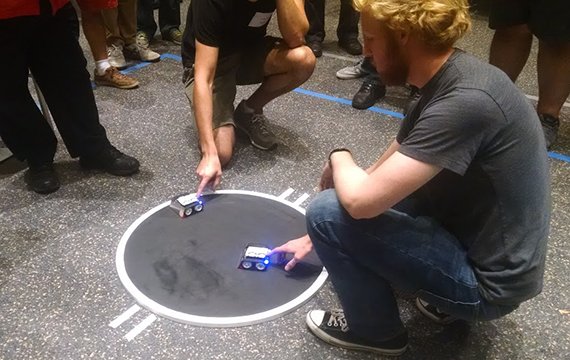Swarthmore Sumo Robots Secure First Place in Local Competition

Erik Jensen '15 enters his sumo robot into the ring.
Ten students recently represented Swarthmore College in a sumo robot competition hosted by Rowan University. Competing against representatives from Rowan and Drexel Universities and James Cook University in Australia, the two Swarthmore teams secured first and fourth places.
The double-elimination tournament was hosted by the Philadelphia chapter of the Institute of Electrical and Electronics Engineers. The winning team of Andrew Taylor ’16, Mercer Borris ’16, Daniel Palmer ’16, and Noah Weinthal ’15 secured their title with their “Matchbot” robot, which beat out 11 competitors in an evening series of bouts in late September.
While many of the teams from other institutions were composed primarily of electrical engineers, Swarthmore’s teams brought academically diverse skill sets to the wrestling ring. According to Erik Jensen '15, whose focus is civil engineering, Swarthmore’s teams were the only groups to have more than one non-electrical engineering major, with representatives from the computer science and political science departments participating in the challenge.
“The Swarthmore teams were far more collaborative than competitive,” says Weinthel, an engineering major from Bethesda, Md. “We tested our robots against each other a few times, but only for the sake of testing the behaviors. We worked together a lot on strategy, and we all cheered for each other as the competition went on.”
The two teams received their sumo robot kits at a workshop held at Rowan University this summer, which they attended at the suggestion of Professor of Engineering Erik Cheever '82. With restrictions on supplementary appendages to the original robot, the teams’ main challenge was programming their palm-sized avatars to move as directed based on limited sensory equipment.
“When we arrived, we found that many of the other teams had been able to attend workshops and work closely with coaches, and in doing so had developed some really cool behaviors for their robots and complex strategies to overcome the robot's sensory limitations,” Weinthel says. “We were hoping our strategy of focusing on our robot more than the other would pay off in the end, but I think we were all surprised that the robot did as well as it did.”
Robots won their matches once they successfully removed their opponents from the competition ring. With no human interaction permitted once the competition began, teams relied on a series of sensors to determine when their robots made contact with competitors or approached the limits of the dueling ring.
Weinthel, who has spent two summers at the College conducting research in the Engineering Department, says the most relevant experience he had prior to the competition was through engineering students’ campus projects – particularly, the installation of a motion-activated “musical staircase” in Sharples Dining Hall.
For Jensen, whose experience with cross-institutional competition includes Widener University’s annual student beam competition, the most enjoyable part of the experience was working within a restrictive set of regulations to nonetheless produce an effective working model. While his team’s robot ultimately proved too slow to secure the title, its innovative design, which featured a slight bend in its snowplow-like flipping structure, showcased students’ savvy in thinking through and beyond restrictive regulations.
“Looking at the rules and figuring out what we could do with that set limitation," he says, "and then seeing our robot for the first time during a real competition was really cool."


